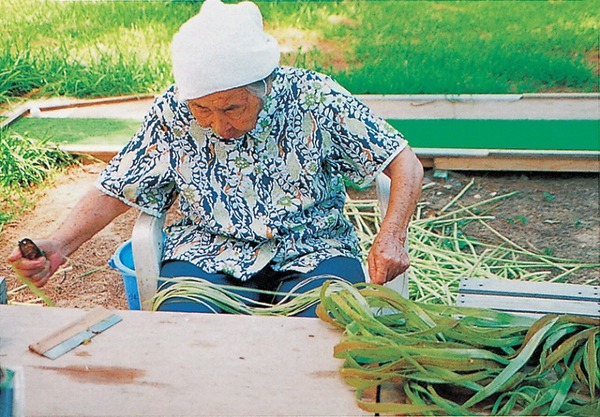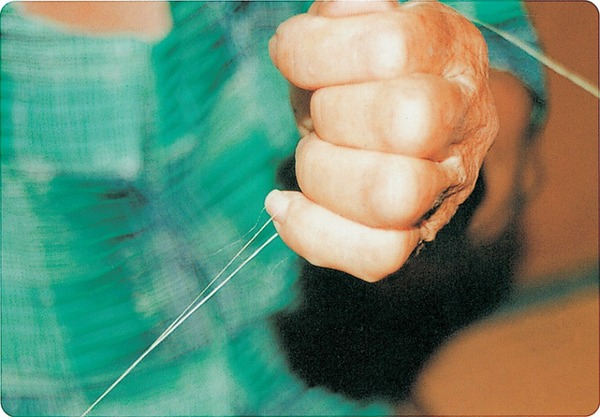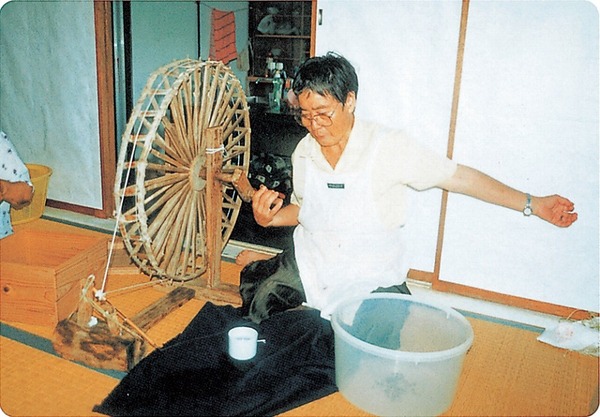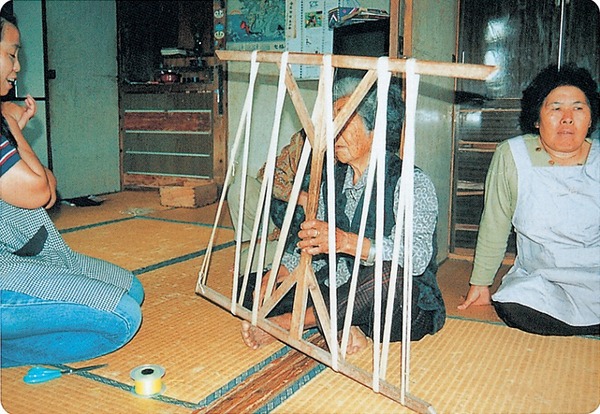トップ > 市の組織 > 教育委員会 > 生涯学習部 > 生涯学習振興課 > 【国選定:選定保存技術】苧麻糸手績み
【国選定:選定保存技術】苧麻糸手績み
〔ちょまいとてうみ〕
苧麻糸手績みは、苧麻(からむし・イラクサ科の多年草・ブーともいう)の繊維を手績み(繋(つな)ぐことの意)して糸を製作する技術である。苧麻糸は、宮古上布等の織物の主要な原材料である。茎の表皮から繊維をとって細く裂き手で績み長い糸を作る。緯糸(よこいと)は、細く裂いた繊維の根元と先端とを撚(よ)り合わせて結び目を作らずに繋ぐ。経糸(たていと)は細く裂いた2本の繊維を撚り繋ぐ。宮古・八重山諸島では、糸績み技術者の多くが自ら苧麻を栽培し、糸を作製するまでの一貫した工程を手がけてきたが、高齢化が著しく、現在約120名の技術者がいる宮古では70歳以上が大半を占め、将来が危ぶまれる。
苧麻糸の手績みは、重要無形文化財「宮古上布」等の沖縄の染織技術の保存・伝承に欠くことのできない技術であり、宮古苧麻績み保存会が認定を受けて、技術の伝承者養成活動を実施している。
【Nationally Selected:Selected Preservation Techinique】Choma Ito Teumi (Choma Thread Twisting)
The Choma Ito Teumi is a technique that hand-twists (connects) the fibers of ramie (Urticaceae family of perennial flowering plants, also referred to as “boo”) to make thread. The Choma thread is the main material for local textiles like the Miyako Jofu. Fibers are collected from the epidermis of the stems and are split finely and twisted by hand to produce long thread. The crosswise threads are connected with the ends of the finely split fibers twisted together, leaving the threads without knots. On Miyako and in the Yaeyama Islands, many of the skilled thread makers worked on the whole process, from cultivation of the ramie to production of thread, but among the approximately 120 thread-makers remaining on Miyako, the majority are over 70 years old, and the future of this technique is at a risk of being lost.
The Choma Ito Teumi is an irreplaceable skill in the preservation and continuation of Okinawa’s dyeing and weaving techniques, such as the Miyako Jofu which is designated as an important intangible cultural asset. The Miyako Organization for Conserving Bunmi Techniques is authorized to carry out the tasks in nurturing the next generation of craftsmen to inherit the skills.
【國家選定:選定保存技術】苧麻線手工織
苧麻線手工織是把苧麻(蕁麻科多年生草本植物・又叫Buu)的纖維用手工繫在一起,製成絲線的技術。苧麻線是宮古上布等織物的主要原料,從莖的表皮取出纖維後,撕成細條再用手工繫成長線。緯線(橫線)是將撕細的纖維根部和尖端搓起,不打結繫在一起。經線(竪線)則將撕細的2根纖維搓成1條。宮古・八重山諸島地區的許多織線技工都親自參與,從栽培苧麻到製做絲線為止的整套工序。但是,隨著人口高齡化加速,大約有120名的宮古技工現在大都已經超過70歲了,未來堪憂。
苧麻線手工織在保存和傳承重要無形文化財產「宮古上布」等沖繩的染織技術中,是一項不可或缺的技術,宮古苧麻織保存會得到國家認定後,現在正實行技術傳承者的培育活動。
【정부 지정:선정 보존 기술】조마이토테우미(조마 실잣기)
조마이토테우미는 조마(모시풀 쐐기풀과의 다년초로 “부”라고도 불린다)의 섬유를 손으로 이어 실을 제작하는 기술이다. 조마 실은 미야코조후(고급 삼베) 등 직물의 주요한 원재료이다. 줄기 껍질에서 섬유를 빼내어 가늘게 잘라 손으로 이어 긴 실을 만든다. 씨실은 가늘게 찢은 섬유 끝과 앞부분을 이어 매듭을 짓지 않고 연결한다. 날실은 가늘게 찢은 두 개의 섬유를 잇는다. 미야코, 야에야마제도에는 실을 잇는 기술자의 대부분이 스스로 모시풀을 재배하고, 실을 만드는 작업까지 일관된 공정을 해 왔다. 그러나 고령화가 현저한 가운데, 지금은 약 120 명의 기술자가 현존한다. 미야코에서는 대부분이 70세 이상이어서 장래가 걱정스러운 상태이다.
모시풀을 손으로 잇는 것은 중요 무형 문화재 “미야코조후” 등, 오키나와의 염색섬유 기술의 보존과 계승에서 빼어 놓고 생각할 수 없는 기술이다. 미야코 분미 보존회는 정부로부터 인정을 받아 기술 계승자 육성 활동을 실시하고 있다.
生涯学習部 生涯学習振興課
電話:0980-72-3764









